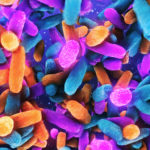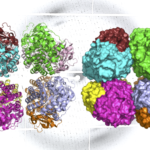A team led by CRISPR pioneer Jennifer Doudna and her longtime collaborator Jill Banfield has developed a clever tool to edit the genomes of bacteria-infecting viruses called bacteriophages using a rare form of CRISPR. The ability to easily engineer custom-designed phages—which has long eluded the research community—could help researchers control microbiomes without antibiotics or harsh chemicals, and treat dangerous drug-resistant infections. A paper describing the work was recently published in Nature Microbiology.
Methane-Eating ‘Borgs’ Have Been Assimilating Earth’s Microbes
A team led by UC Berkeley’s Jill Banfield discovered DNA structures within a methane-consuming microbe that appear to supercharge the organism’s metabolic rate. In a nod to the Star Trek universe, they named the genetic elements “Borgs” because the DNA within contains genes assimilated from many organisms.
All-star Scientific Team Seeks to Edit Entire Microbiomes with CRISPR
CRISPR enzymes are like super scissors: they cut, delete, and add genes to a specific kind of cell, one at a time. But now, UC Berkeley faculty and Biosciences Area researchers have figured out how to add or modify genes within a microbial community of many different species, coining the phrase, “community editing.”
Study Finds ‘Missing Link’ in the Evolutionary History of Carbon-Fixing Protein Rubisco
In a study appearing in Nature Plants, researchers from UC Davis, UC Berkeley, and Berkeley Lab report the discovery and characterization of a previously undescribed lineage of form I rubisco – one that the researchers suspect diverged from form I rubisco prior to the evolution of cyanobacteria. The novel lineage, called form I’ rubisco, gives researchers new insights into the structural evolution of form I rubisco, potentially providing clues as to how this enzyme changed the planet.
The work was led by Patrick Shih, a UC Davis assistant professor and the director of Plant Biosystems Design at the Joint BioEnergy Institute (JBEI), and Doug Banda, a postdoctoral scholar in his lab.
Banfield Team Studies Huge Bacteria-eating Viruses
Jill Banfield, an Earth and Environmental Sciences Area faculty scientist with a secondary appointment in the Environmental Genomics & Systems Biology Division, co-led a team to discover 351 different huge bacteria-eating phages. One of these is the largest bacteriophage known to date–with a genome that at 735,000 pairs long–is nearly 15 times longer than the average phage.
- 1
- 2
- 3
- 4
- Next Page »
Was this page useful?








